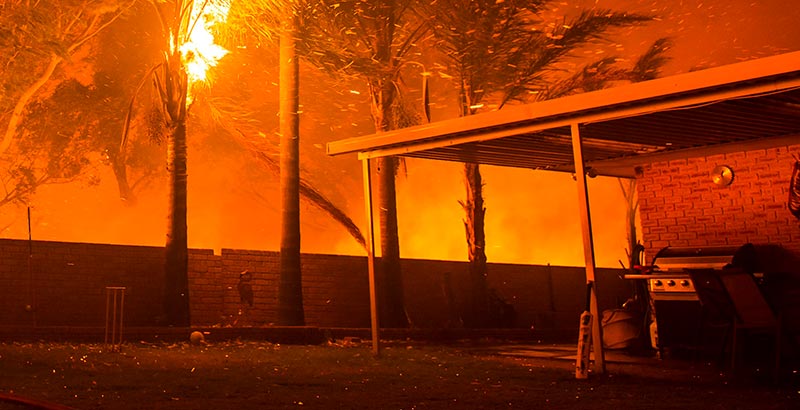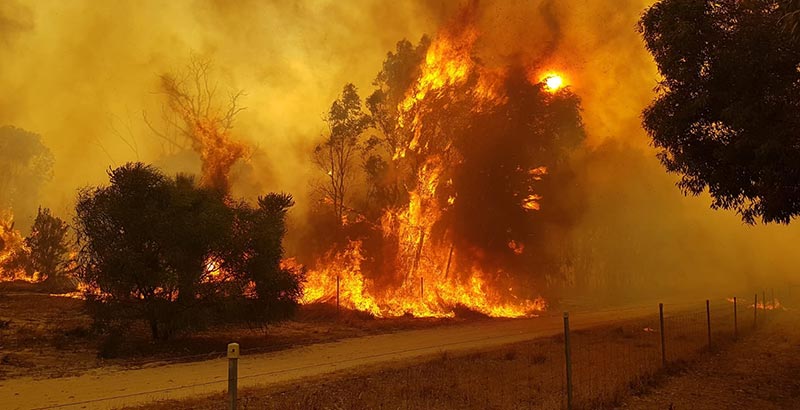Fire or life threatening emergencies: 000
Emergency Information: 13 3337
SES Emergency Assistance: 132 500
When a bushfire starts, things can change in a matter of minutes. So you need to keep connected and updated regularly during bushfire season.
Create an emergency plan and follow official warnings on Emergency WA, to give you and your family the best chance to act early and leave for a safer place.
If you decide to stay and defend your property, be aware that this will take enormous effort, both physically and emotionally, and you need to be very well prepared. Trying to leave when it’s too late is extremely dangerous.

Bushfires are unpredictable and your options for staying safe can disappear in just a few minutes. You will be making lifesaving decisions under enormous stress, so leaving early is the safest way for you and your family to survive a bushfire.
Get connected: Connected communities are safer communities.
Stay alert: If you can see or smell a bushfire, that's your warning.
Monitor official warnings: Never rely on one source of information.
Keep your landline and mobile phone providers updated.
Remember: No warning system is foolproof! If there is a bushfire in your area, put your emergency plan into place immediately rather than waiting for a warning text because you may not get one.

You will need to put in huge physical and mental efforts for many hours to actively defend your property before, during and after a fire. Conditions will be unbearably hot. Your home is your best protection in a bushfire ONLY if it is well constructed, maintained and prepared.
Most homes lost in bushfires are set alight by burning embers. Burning embers are around before, during, and up to several hours after the fire front has passed your property. So be prepared to put out spot fires caused by embers and you may save your home and other buildings.
You are confident your home is well prepared and maintained
You have sufficient emergency water supplies and equipment
You are confident you and your family could deal with the stress of a fire
You and your family are in good health
Remember that waiting to leave until the very last minute is extremely dangerous. You will face smoke, noise, heat, flames, panic on the roads and emergency service vehicles dealing with the fire. It is much safer to stay in your home than to flee as a fire approaches.
This should be your last option. However, bushfires are very unpredictable, so even if you don’t intend to stay and defend your property, you need to be well prepared to shelter in your home when plans fail and you can no longer leave safely.
Remain in your home while the fire front is passing, and shelter in a room furthest from the fire front. Make sure the room has at least two ways to get outside, and has a water supply. People have died sheltering in rooms without a second exit door.

Shelter for as long as possible. But if your home catches fire and the conditions inside become unbearable, you should leave to avoid toxic smoke and fumes. Leave through the exit door furthest from the approaching fire. The majority of people die in a bushfire from radiant heat, so wear protective clothing and go to an area that has already been burnt.
Your bushfire survival plan should identify a place where you and your family can go to shelter as a last resort when it’s no longer safe to stay and actively defend your home. Consider places such as a local open space, a dam or a beach.
Remember that safer places do not guarantee safety in all circumstances. Safer places may not provide shelter from bushfire elements such as flying embers and heat.
If you live within 500 metres of bushland and have a roof-mounted evaporative air conditioning unit, your home may be at increased risk of ember attack. Embers are pieces of burning bark, leaves or twigs carried by the wind during a bushfire.
Embers can get into your air conditioning unit and start a fire in your roof space that spreads rapidly throughout your home. An ember protection screen can reduce your risk and help save your property.